Creating Articles in Drupal
Articles in Drupal are a content type with a predefined set of fields that are optimized for time-sensitive content, media, and categorization. They’re an excellent way to publish content that benefits from being tagged, categorized, and featured on your site.
Step-by-Step Guide to Creating Articles
1. Access the Content Creation Area
- To get started, navigate to Content in your Drupal admin toolbar, then click on Add Content. Here, select Article from the list of content types available.
2. Fill in the Article Details
- Title: Provide a compelling title for your article. This will serve as the headline.
- Body: Enter the main content of your article. Utilize the text editor to format your text, and don’t hesitate to incorporate images, links, and multimedia to enhance your article.
- Tags: Use the Tags field to enter relevant keywords that describe your article. Tags help with site organization and can improve SEO and user navigation.
- Image: Most Article content types come with an Image field by default. Use this to upload a relevant, eye-catching image representing your article’s topic. This image is often displayed as a thumbnail in listings or at the top of your article.
3. Set the URL Alias (Optional)
- Creating a user-friendly URL alias for your article can improve SEO and make the link more memorable. Consider a structure like articles/your-article-title.
4. Configure Publishing Options
- Decide on the visibility and publishing settings of your article. You can publish it immediately, save it as unpublished (draft), or schedule it for later publication. Ensure the Published option is checked if you want the article to go live right away.
5. Review and Save
- Before saving, review your article for any errors or formatting issues. Once everything looks good, click the Save Your article will now be live on the site, accessible through its URL or any menus/tags it’s associated with.
6. Add to Menu (Optional)
- If you want your article to be directly accessible from the main menu or another navigation structure, go to Structure > Menus in your Drupal admin. Add a new menu link pointing to your article, ensuring it’s placed appropriately for your site’s navigation design.
Creating Pages in Drupal
Step-by-Step Guide to Creating and Publishing Pages
1. Navigate to the Content Addition Area
- From the Drupal admin toolbar, select Content and then click on Add content. This action displays the available content types. Choose Basic Page to create general-purpose web pages.
2. Enter Page Details
- Title: Provide a title for your page. This title is critical as it typically appears as the page’s main heading (H1) and is used in navigation links.
- Body: Add the body content of your page in the provided text area. Drupal’s rich text editor allows you to format text and insert images, links, and lists to make your content engaging and informative. For static pages like ‘Services’ or ‘Contact Us,’ ensure the content is clear and directly serves the intended purpose of the page.
3. Set the URL Alias (Optional)
- It’s best practice to set a user-friendly URL alias for your pages. This enhances SEO and usability. Under the URL alias section, you can manually specify an alias, such as about-us, for an About Us page.
4. Adjust Menu Settings (Optional)
- If you want this page to be accessible through the site’s main navigation or other menus, expand the Menu settings Check the box for Provide a menu link, then fill in the Menu link title, which is the text that will appear in your site’s navigation. Choose the parent item if this page should nest under another menu item, and set the weight to adjust its order among other menu items.
5. Configure Publishing Options
- In the Publishing options section, you can control the visibility of your page. Make sure to check Published if you want the page to be live immediately upon saving. You can also control whether the page is promoted to the front page or sticky at the top of lists, though these options are more commonly used for articles and blog posts.
6. Review and Save Your Page
- Before clicking the Save button, review your page for accuracy and completeness. Once saved, your page will be live on your Drupal site according to the publishing options and URL alias you’ve set.
7. View Your New Page
- After saving, visit your new page on the front end of your Drupal site to ensure it appears as expected. This is also a good time to test any navigation links to the page to ensure they work correctly.













































